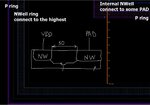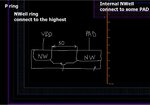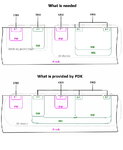mult
Junior Member level 1
How to implement "latch-up" guard rings and prevent parasitic lateral NPN at the same
Hi all.
I am trying to create latch-up guard rings for IO "low-side" BJT_36V and HVNMOS_36V according to TSMC BCD 0.18 design rule.
And there is a requirement of design rule to keep huge space between two Nwells connected to two different pads to prevent parasitic NPN. Space is so great (50um) that the very idea of creating rings seems impracticable.
Please see the picture.

If I use smaller distance I get DRC violations.
I don't know is it really possible to be turned on for this parasitic transistor in some the worst coincidence, so I am not sure if I can waive such DRC violations and use acceptable dimensions.
Please advice!
Hi all.
I am trying to create latch-up guard rings for IO "low-side" BJT_36V and HVNMOS_36V according to TSMC BCD 0.18 design rule.
And there is a requirement of design rule to keep huge space between two Nwells connected to two different pads to prevent parasitic NPN. Space is so great (50um) that the very idea of creating rings seems impracticable.
Please see the picture.

If I use smaller distance I get DRC violations.
I don't know is it really possible to be turned on for this parasitic transistor in some the worst coincidence, so I am not sure if I can waive such DRC violations and use acceptable dimensions.
Please advice!


